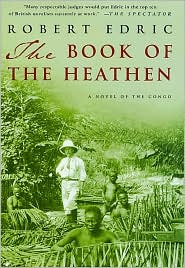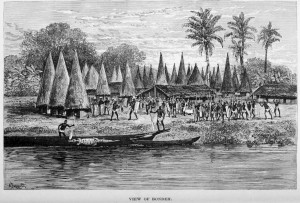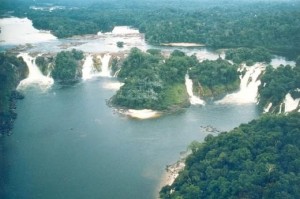The Heart of Darkness has never been so dark.
 It is 1897, and a motley group of British functionaries is running a concessionary station, only marginally successful, in Ukassa Falls in the Congo Free State, trading and exploring, mapping new areas of the country for further exploration, and using natives to strip minerals from quarries. Individually, however, their primary mission is protecting themselves and their jobs, while keeping an eye on a more lucrative Belgian enterprise across the river and on the slave-trader Hammad, who fancies himself the potential emperor of a future, native-run country. When gunfire signals the arrival of an unexpected visitor, Capt. James Frasier hopes it means the return to British jurisdiction of his friend, Nicholas Frere, who, missing for 51 days in the wilderness, is now in Belgian custody, awaiting trial for killing a native child.
It is 1897, and a motley group of British functionaries is running a concessionary station, only marginally successful, in Ukassa Falls in the Congo Free State, trading and exploring, mapping new areas of the country for further exploration, and using natives to strip minerals from quarries. Individually, however, their primary mission is protecting themselves and their jobs, while keeping an eye on a more lucrative Belgian enterprise across the river and on the slave-trader Hammad, who fancies himself the potential emperor of a future, native-run country. When gunfire signals the arrival of an unexpected visitor, Capt. James Frasier hopes it means the return to British jurisdiction of his friend, Nicholas Frere, who, missing for 51 days in the wilderness, is now in Belgian custody, awaiting trial for killing a native child.
At an agonizingly slow pace, Edric builds the tension and an ominous sense of mystery. Though he readily admits his guilt, Frere refuses to defe nd himself, simply accepting whatever fate has in store. He is almost certain to be turned over to local authorities in Brazzaville for trial and hanging, eventually, but he will not tell anyone, even Frasier, the circumstances of the child’s death.
nd himself, simply accepting whatever fate has in store. He is almost certain to be turned over to local authorities in Brazzaville for trial and hanging, eventually, but he will not tell anyone, even Frasier, the circumstances of the child’s death.
Edric’s characters come to life through their conversations, conflicts, and actions, rather than through passive descriptions or long biographies. The reader, too, must be active, accumulating important details on his own by observing the action, some of it intense, and participating in it, however reluctantly. Several grim and explicit scenes of atrocity attest to Ed ric’s abhorrence of the mistreatment of indigenous people (the subject also of his novel Elysium, set in Tasmania) and of the destruction of birds and wildlife. His opposition to colonial arrogance, religious fanaticism, mindless bureaucracy, and lock-step adherence to rules and regulations underlies all the action here.
ric’s abhorrence of the mistreatment of indigenous people (the subject also of his novel Elysium, set in Tasmania) and of the destruction of birds and wildlife. His opposition to colonial arrogance, religious fanaticism, mindless bureaucracy, and lock-step adherence to rules and regulations underlies all the action here.
Describing the wilderness as “more permanent and invincible than anything else I can imagine, something as potent and as indestructible as evil or truth itself,” Edric transmutes it into a living force which dramatically affects all its inhabitants. The river, with its traffic, both unites and divides, and when, at flood tide, it scours its banks and destroys pilings and jetties, one cannot help but see parallels with the interrogat ions of the steadfast Frere. Images of light and dark and echoes of Heart of Darkness are constant, and when “the horror” is finally revealed at the end, it out-horrors anything Conrad ever dreamed of. With a conclusion full of literary pyrotechnics, this is a chilling recreation of the worst nightmares of colonialism and of man’s inhumanity to man.
ions of the steadfast Frere. Images of light and dark and echoes of Heart of Darkness are constant, and when “the horror” is finally revealed at the end, it out-horrors anything Conrad ever dreamed of. With a conclusion full of literary pyrotechnics, this is a chilling recreation of the worst nightmares of colonialism and of man’s inhumanity to man.
Notes: The author’s photo and a terrific interview appear on http://www.thisishullandeastriding.co.uk
Henry Morton Stanley’s drawings of the “founding of Congo Free State” in 1885, may be found in http://commons.wikimedia.org
Boyoma Falls in the Congo are a potential source of power: http://fizzyenergy.com. It has seven sets of waterfalls, with the average height of two hundred feet.
